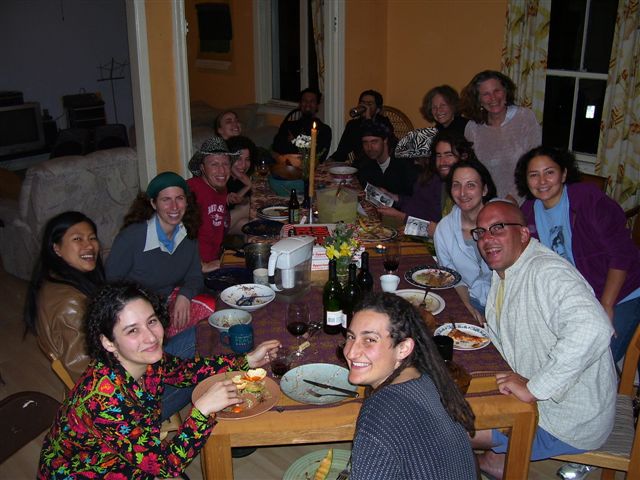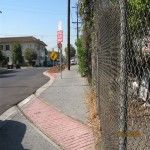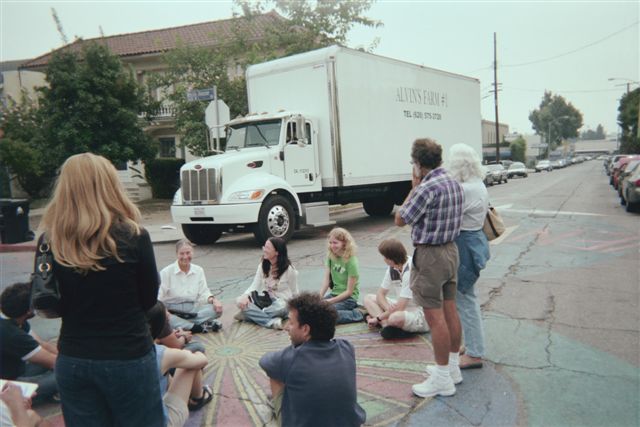It’s a gimmick that Lois Arkin is known for. Near the conclusion of the tours she leads at the Los Angeles Eco-Village – the micro-community she founded that aims to demonstrate ecological, social, and economic sustainability – Arkin shepherds her guests out into the adjacent two-lane road, called Bimini Place.
On a recent weekday along this two-block, eleven-acre, mixed-use zone located on the edges of L.A.‘s Koreatown and East Hollywood neighborhoods, the guests include a University of Southern California political science professor, his nine students, and a writer. Arkin invites the visitors to stand in a circle that encompasses half of the two-lane road. They hit the streets, electing to participate in what Arkin calls a “car retraining” exercise.
While the newcomers raise eyebrows, glance at one another other, or at minimum, quit text messaging and keep their eyes focused on the approaching automobiles, Arkin begins waving with theatrical enthusiasm at the first five vehicles to drive by.
The vehicle operators maneuver into the opposing lane, looking nonplussed. Undeterred, Arkin keeps gesturing hello as more cars and trucks creep by. Then – incremental progress. Car six, the driver smiles. Car seven, the driver nods. Truck eight, a pleasant wave. And eureka, the driver of the ninth vehicle salutes Arkin et al. with a friendly toot of the horn as well as a vigorous wave.
“Sometimes,” Arkin had just told the group while this not-so-pedestrian Los Angeles drama played out, “they want to have a stand-off, or a war.”
If war is hell, Lois Arkin has spent the past three decades trying to create a well-mulched sliver of L.A. heaven. Back in1980, the Detroit-born daughter of – irony alert – suburban and wetland developer James Raisin founded the non-profit CRSP. Pronounced, “crisp,” as in the corners of a well-fitted sheet, the initials stand for Cooperative Resources and Services Project.
On paper, the L.A. Eco-Village began in 1993. Three years later, CRSP purchased outright – no corporate bank mortgage here – a foreclosed and run-down 40-room, U-shaped building. The purchase was made thanks to loans from individuals to CRSP’s Ecological Loan Fund – that’s ELF for short, but not that ELF.
Called the “Bimini Arms,” the edifice was constructed in 1922 and likely originally hosted long-term guests and workers of the Bimini Baths, a spa that was located on this block during the first half of the 20th century. “People drilling for oil in the late 1800s, they hit hot water instead,” says Joe Linton, a longtime Eco-Village resident whose well known in regional policy and advocacy circles for his work regarding the Los Angeles River.
While Eco-Villagers have a long-term plan that involves bringing back the baths – more on that below – the 40-unit building already functions as a gathering place and would-be healing zone. A lobby holds couches, a piano, aquarium, “take a book, leave a book” shelves, and a “free table,” which resembles the aftermath of a multi-family yard sale. Upstairs, another communal room hosts both weekly potluck dinners and the process- and rule-based weekly meetings held to decide, by consensus, Village business.
Then, there’s the Arms’ signature flora-filled and permaculture-principled courtyard. The botanical bounty, situated in the space between the U-shaped Arms’ three sides, brims with as many as 85 types of vegetation, plants and trees that produce the likes of figs, apples, pomegranates, bananas, apricots, peaches, plums, loquats, lemongrass, strawberries, artichokes. Two roosters and three chickens reside in a coop. Bees and butterflies buzz and flutter. Spiders hide out in the composting.
Linton lives next door, in the eight-unit Bimini Terrace building, which CRSP purchased, again outright, in 1999. The Terrace has solar panels on the roof. “I can show you,” Linton says. “My meter runs backwards right now.” Energy experimentation isn’t new to this block. As it turns out, neither is advocacy. “There were all kinds of demonstrations on this street because the baths were not integrated,” Arkin says. The baths, like the trolley cars that once ran alongside Bimini Arms, were shut down during the 1950s.
These days, out on that same street, Arkin’s tour guests are doing their traffic calming exercise in what is indeed a city of Los Angeles-sanctioned “Shared Street Project.” Meaning that autos and the ambulatory are municipally mandated to make peace. And meaning that while Arkin might be playing chicken, she’s crazy like a fox.

So after that ninth vehicle waves and happily honks, Arkin leads her tour group down the block, past the neighboring drug and alcohol rehab clinic – community service includes helping at the Village, Arkin says – and past the building that she says used to be the home of the Daily Racing Form, that tout sheet of record for the sport of kings. The tour concludes with a visit to the community center with playground and well-landscaped, boulder-strew Bimini Slough Ecology Park that Villagers helped make happen.
While there, Arkin talks about the Eco-Village’s vision for the neighborhood at-large. That ideal includes restoring the Bimini Baths to create an indoor pool for use by children at nearby schools; adding “green retail” small businesses in what’s currently an asphalt alleyway; moving beyond the first phase of traffic calming to create a completely auto-free district; and crafting a “biological living machine,” to clean and reclaim water. That’s in addition to the in-progress effort to affordably turn interested Village renters into owners, while turning the land over to a trust.
It’s pointed out to Arkin that over a handful of generations, then, this small stretch of Los Angeles turf has been home to oil wildcatters, resort operators, thoroughbred fanatics, and a utopian Eco-Village. Don’t all of the above have one thing in common, Arkin is asked – that each is the work of gamblers?
“No,” Arkin says, with a quick laugh. “I’m one of the worst gamblers. I think the continuity in the neighborhood is social activism.”
All photos courtesy Lois Arkin
Next Monday:
Elephants in Pershing Square? – Planner James Rojas exclaims, “I just built the Next American City!”




_920_518_600_350_80_s_c1.jpg)












